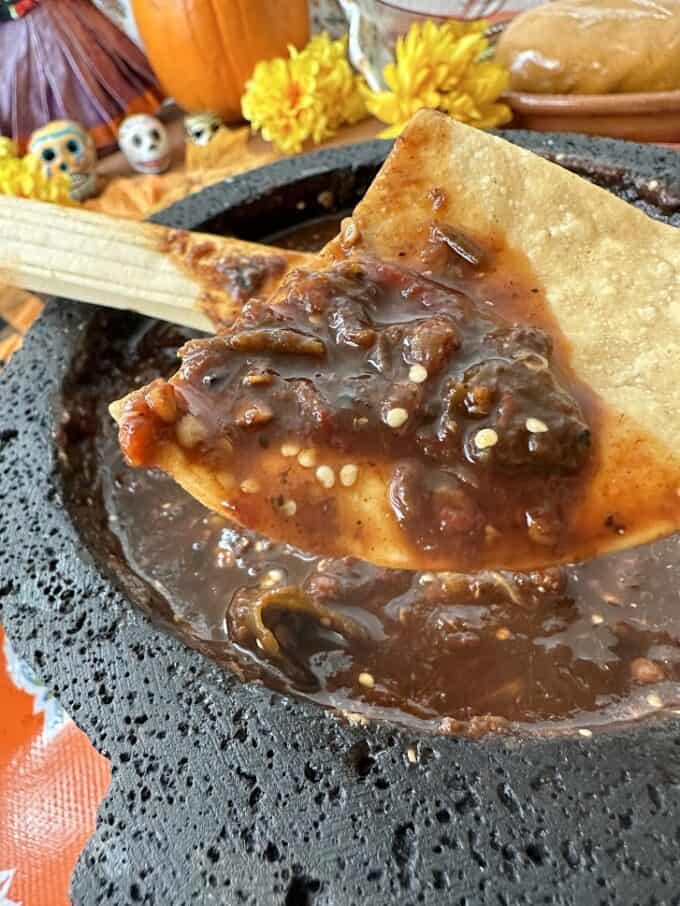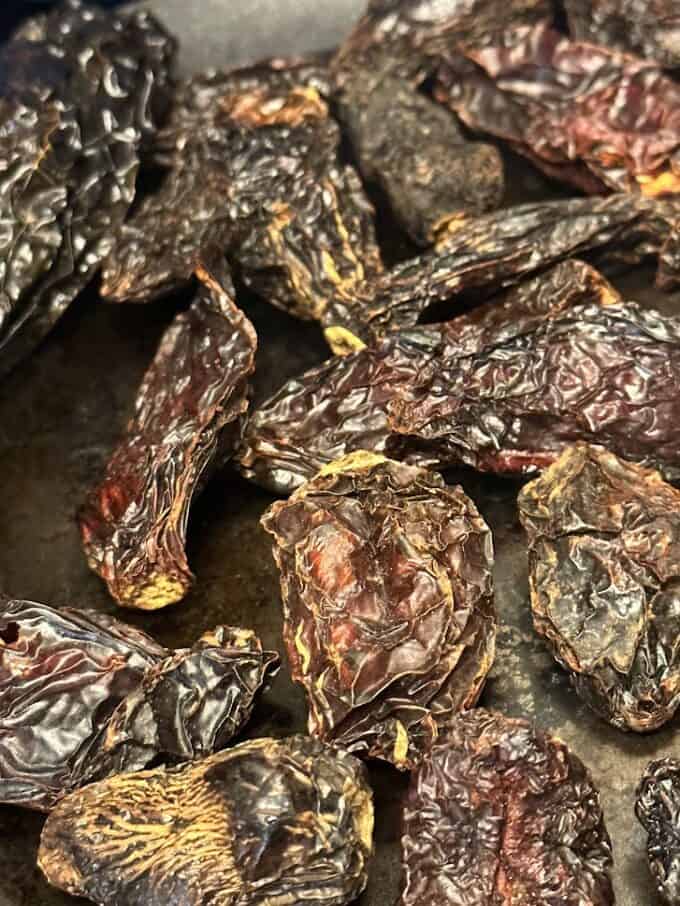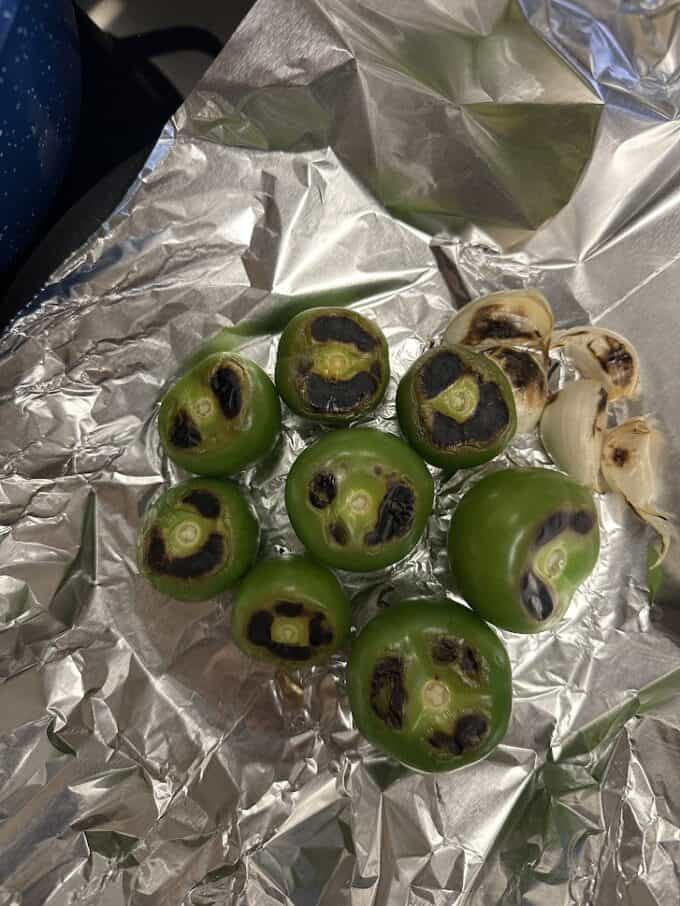What is salsa negra martajada? Salsa martajada refers to a salsa that has been chopped or blended by hand using a volcanic rock mortar and pestle, a molcajete. Negra means black, referring to the dried chiles that almost look black in their dry state. Plus the toasting of the dried chiles may yield some blackened spots. Realistically, the finished salsa negra has different shades of brown, rust, red and almost black tones. It’s a beautiful salsa!

Some salsas are meant to be spicy!
I admit, I am spicy food lover, but it’s not for everyone. If you wanted to recreate this salsa recipe in a milder version, it is possible. I would only use 1/3 of the chile morita and use 4 large chile ancho in addition to the chile negro. The ancho pepper is mostly mild and will still yield that beautiful dark color.

Have you worked with smoky chile morita before?
Chile morita is a smoked dried version of a fresh red jalapeño! Yes, red jalapeño. They are similar to dried chipotle peppers, but are dried for less time. Red jalapeños can be found in some larger Mexican markets or in farmers markets towards the end of the harvest. Typically jalapeños are picked green. But when allowed to ripen longer, they will become red in color. The red version is most times hotter, but also with a hint of sweet. I am a chile morita fan!!
Toasting the dried chiles on a dry comal

You will first get a slight aroma, then you may see wisps of smoke as they toast.

I am all for easy clean up! You don’t have to line the comal with foil paper, but it sure helps clean up go a lot smoother.

Will it be the same if I use a blender? It will still be delicious, but it won’t have that glossy molcajete finish.

In my experience, I find the skins of the tomatillos a bit hard to blend in the molcajete. For this reason, many times I roughly chop them before adding them to the molcajete.

Any coarse salt works for this process. It acts as an abrasive and helps to break down the ingredients.

Molcajetes are a good tool to have in your kitchen!
It’s not just for decoration, lol! Many time I hear of people who have inherited their mom’s or abuela’s molcajete and they place it in the cupboard never to be seen again. It’s useful for a well seasoned garlic paste, whole spices and of coarse for preparing all kinds of salsa recipes. You can get tips right on my blog on how to cure and season a molcajete!

Just a little bit of dry roasting time will mellow out the flavors of that fresh garlic.
I love garlic! I grew up with salsas with NO garlic. Mom never added garlic to her homemade salsa recipes. Why? Unfortunately, I didn’t get a chance to ask her why. She did state that her mom(my abuelita) never added garlic to her salsa. Later I found out that the garlic wasn’t added due to the fact that the salsa would spoil faster. Heck salsa didn’t even last that long in our house for it to spoil, lol! These days, I add garlic to all of my salsa recipes.

Look how beautiful those chile morita rehydrate!

How long will this salsa last?
Refrigerated, this salsa can last up to 10 days or more since it contains a lot of chile peppers.

If tomatillos are hard to come by, you can use roma tomato instead.
This is a great recipe for when you can only find canned tomatillos. In a pinch, you could mix in a jar of your favorite salsa verde to the processed dried chiles. it works!

Let us get to the recipe below already!

I absolutely love the photo above before the salsa negra martajada reaches it’s final mix!

Do you see what I mean about that glossy finish when prepared in a molcajete?


Salsa Negra Martajada-Chile Morita Molcajete Salsa
Equipment
- Molcajete
- griddle or comal
Ingredients
- 6 cloves of garlic
- coarse sea salt, to taste
- 2 dried chile negro, long and skinny remove stems and seeds
- 12 dried smoky chile morita typically they come with no stems. Leave seeds for heat
- 8 medium tomatillos
- Water
Instructions
- On a large griddle or comal, place the dried chiles at medium heat.
- At the same time, heat 4 cups of water in a pot, at medium heat.
- After a few minutes the chiles will begin to become aromatic and start toasting. Turn as needed for the next 2 minutes, making sure the chiles don't burn. Transfer all the chiles to the warming pot of water. Let them soak while you finish preparing the other ingredients.
- On that same hot griddle or comal, add a section of foil paper. Place the tomatillos and the garlic. You can drizzle 1 tsp of oil on the ingredients to help them roast a little faster. Roast, turning as needed for 20 minutes, removing the garlic after 15 minutes. Wrap the foil paper around the ingredients for a 10 minutes. This will help them finish cooking all the way through.
- When ready, remove the outer husk from the cloves of garlic and transfer them to the molcajete. Pour in 1 tsp. of salt. Grind into a paste. Roughly chop the tomatillos for easier grinding in molcajete.
- Gradually add a few of the softened chiles to the molcajete and grind down as best you can. If the molcajete is large enough, gradually process the cooked tomatillos in the molcajete with the chiles and garlic. if the salsa is too thick, mix in a little bit of water until you have the desired consistency. Taste for salt. Serve with your favorite Mexican dishes!
- Variation: Mix in some finely diced onion and chopped cilantro with cubed avocado for an over the top Molcajete Salsa! To achieve a smoother salsa, you can use a blender if you prefer.
Would Love to Hear From You